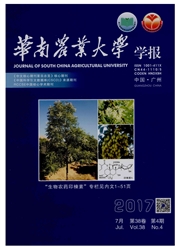

 中文摘要:
中文摘要:
【目的】揭示伯乐树Bretschneidera sinensis地理分布格局,预测其潜在适生区,探讨环境和气候因子对其地理分布格局的影响.【方法】基于1950—2000年期间及21世纪70年代的19个气候因子数据以及中国13个省区、110个有记录的地理分布点,利用最大熵算法模型(Maxent),结合地理软件DIVA-GIS和ARCGIS,预测伯乐树的潜在适生区.结合野外调查和标本数据,以海拔图层和植被覆盖图层为底图绘制该种地理分布.【结果和结论】伯乐树潜在适生区位于华南地区,最适分布区位于南岭地区以及罗霄山和幕阜山.该种常见于海拔500~2 000 m的山地常绿阔叶林、常绿针叶林和落叶阔叶林,适宜气候条件为最暖季度平均雨量500~2 750 mm,昼夜温差7.8~9.8℃.随着全球气候变化,该种潜在适生区北移,最适分布区面积减少.基于此,还分析了主导环境和气候因子对该种地理分布格局的影响,并对其保护策略提出了建议.
 英文摘要:
英文摘要:
【Objective】The present study aimed to investigate the geographical distribution pattern and predict the potential distribution range of Bretschneidera sinensis,a rare Tertiary tree species in China.【Method】A maximum entropy algorithm modelling program( Maxent) and GIS software systems of DIVA-GIS 7. 4. 0 and ARCGIS 9. 1 were used to construct ENM based on 110 occurrences in 13 provinces or regions and 19 climatic factors in 1950—2000 and the 2070 s.【Result and conclusion】Bretschneidera sinensis exists in subtropical evergreen broadleaved forests,evergreen needle-leaved forests or deciduous broadleaved forests in middle mountain regions at an altitude between 500 to 2 000 m,with a warm temperature and abundant precipitation. The most suitable habitat was predicted to be located in the ranges of Mts. Nanling,Mts. Luoxiaoshan and Mts. Mufushan. The most suitable environmental conditions forB. sinensis were revealed to be characterized by the precipitation of the warmest quarter with an average rainfull between 500 and 2 750 mm and a day-night temperature difference between 7. 8- 9. 8 ℃. With the global climate change,the potential distribution range of B. sinensis shows a trend to move northwards in response to global warming. Therefore,environmental and climatic factors involved in the geographical distribution and endangered status of B. sinensis have been analyzed. Accordingly,conservation strategies are suggested for in situ and ex situ conservation of B. sinensis.
 同期刊论文项目
同期刊论文项目
 同项目期刊论文
同项目期刊论文
 期刊信息
期刊信息
